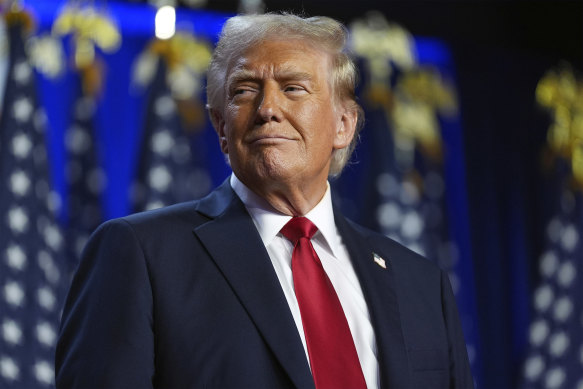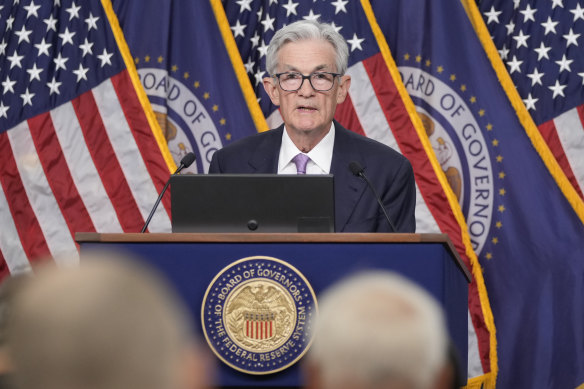Opinion
Trump’s Machiavellian plot to undermine the man he would love to get rid of
Stephen Bartholomeusz
Senior business columnistAfter Federal Reserve Board chair Jerome Powell made it clear he has no intention of relinquishing his powerful position, Donald Trump’s advisers have been busy working on a “Plan B” to neutralise him.
At a press conference last week to discuss the Fed’s latest 25-basis point cut to US interest rates, Powell was asked whether he would resign as Fed chair before his term ends in May 2026 if Trump asked him to.

Donald Trump has made it clear that he believes he should have some say in the Fed’s interest rate decision-making.Credit: AP
“No,” was the reply.
Does a president have the right to fire you or other Fed leaders?
“Not permitted under the law.”
Trump wanted to fire Powell during his last term as president for not cutting rates as fast as Trump wanted, only to discover that he didn’t have that power. Fed chairs can be fired only for “cause”, which is generally interpreted to mean serious misconduct or impropriety.
So, Trump is stuck with Powell until mid-2026, when his term as chair, but not as governor, expires. Fed governors are appointed for 14-year terms, so Powell will remain on the Fed’s board until January 2028.
Moreover, the Federal Open Market Committee chair (currently Powell) is elected by the members of that committee, which is the body that actually sets US monetary policy. So Trump could replace Powell as Fed chair in 2026 (he has said he won’t reappoint him) only to find that Powell remains chair of the Federal Open Market Committee and spokesman for its monetary policies.
Trump has made it clear that he believes he should have some say in the Fed’s interest rate decision-making.
“I think that in my case, I made a lot of money, I was very successful, and I think I have a better instinct than, in many cases, people that would be on the Federal Reserve or the chairman,” he said earlier this year.

Fed chair Jerome Powell has been a thorn in Donald Trump’s side for years.Credit: AP
Powell effectively said last week the Fed would not consider Trump’s policies before they were implemented and that it could evaluate their effects.
“We don’t guess, we don’t speculate, and we don’t assume,” he said. Nevertheless, if Trump’s agenda was inflationary, the Fed would be forced to tighten monetary conditions, and US monetary and fiscal policy would collide.
Thus, there is a very real prospect of a confrontation between Trump and the Fed during his next term as president.
At the moment, with the inflation rate subsiding towards the Fed’s target of 2 per cent, the Fed is in rate-cutting mode. Last week’s 25-basis point cut followed a 50-basis point cut in September. Economists expect another 25-basis points reduction next month and, before the election, they had been pricing in three or more rate cuts next year.
The extraordinary success of Trump and the Republicans – control of the White House, the Senate and probably the House of Representatives – means Trump ought to have an unchecked ability to implement his policy agenda.
His key policies, which have implications for US monetary policy, are his tax cuts, tariffs and immigration policies. If implemented in the form he has outlined, these would be highly inflationary.
Trump’s policies could add another $US7.75 trillion ($11.75 trillion) to US deficits and debt over the next decade (the United States is already running annual deficits approaching $US2.5 trillion) and greatly increase the already massive supply of US Treasuries being issued into the bond market.
While it might take some time for the impact to show up in economic data, the pressure on the Fed to reverse course and start raising US rates again to head off renewed inflation – possibly as early as very late next year or early 2026 – would mount.
Trump and his advisers don’t want the Fed to implement policies that would conflict with their agenda, hence the significant amount of time they and the various pro-Trump think tanks have devoted to devising strategies for taking control of the Fed or at least muzzling it.
The last time he was in office, Trump tried to fill the Fed’s board with his own nominees. However, largely because of the nature of the nominees – a pizza company executive whose campaign for the 2012 presidential nomination was derailed by allegations of sexual misconduct, and an economics commentator found in contempt of court for unpaid alimony – the attempt was unsuccessful.
This time, with only Powell and one other Fed governor’s terms as governors expiring during his presidency, there’s not much scope for board stacking, which has led to some creative thinking by Trump’s advisers.
One idea circulating in Republican circles is to demote Powell’s vice chairman, Michael Barr, who is responsible for financial regulation. Barr has drawn the ire of the banking system for advocating a higher capital adequacy level after last year’s US regional banking crisis.
The proposal is quite Machiavellian.
At its most straightforward, it would remove (with enthusiastic support from the bank lobby) an impediment to Trump’s deregulatory agenda. The banks expect Trump and a Republican-dominated Congress to relax prudential standards as the administration pursues pro-growth policies.
That’s what happened during his last term, when Fed vice chair Randal Quarles was a Trump appointee who favoured a deregulatory approach. A report commissioned by Barr into the regional bank collapses pointed the finger at the Fed and Quarles, and the deregulation laws passed by Congress, as contributing factors to the crisis.
Now that Republicans control the Senate, removing Barr, whose term as vice chairman also ostensibly expires in May 2026, could enable Trump to put his own nominee into that role.
There is a very real prospect of a confrontation between Trump and the Fed during his next term as president.
It is unclear whether the White House or Congress has the legal authority to force Barr out of the vice chairmanship. They couldn’t force him off the Fed board before his term ended in 2023 but Trump’s advisers appear to believe they can.
That’s where the proposal could become threatening to Powell and the Fed, as the plan envisages the Trump appointee to be a “shadow” chair, critiquing Fed decisions and providing their own forecasts and guidance on interest rate decisions, and because they would be Trump’s nominee when Powell’s chairmanship ends, steadily undermining Powell and gaining influence within financial markets.
Wall Street investor Scott Bessent is credited with developing the plan and is a potential Trump nominee for the vice chair’s role.
If it is legal, it is a clever idea but because it would undermine the Fed’s credibility as an inflation fighter, one which could add to the bond market concerns about the reflationary implications of Trump’s agenda.
If the Fed is unwilling to kill off a new bout of Trump-inspired inflation, the bond market vigilantes have demonstrated in the past that they will do the job instead, forcing up US bond yields.
Indeed, there’s already been a touch of that recently, when yields rose against the trend of the Fed’s rate-cutting cycle since it became likely, and then certain, that Trump would return to the White House and, with control of Congress, that he would be able to implement his radical economic agenda.
The Market Recap newsletter is a wrap of the day’s trading. Get it each weekday afternoon.